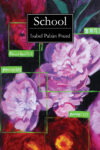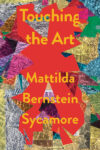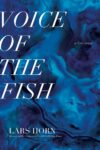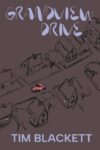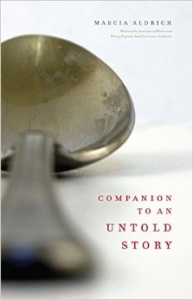 [University of Georgia Press; 2012]
[University of Georgia Press; 2012]
In a footnote, Marcia Aldrich quotes a description of Companion to an Untold Story from a grant proposal that she submitted in 1999, thirteen years before the book’s publication in 2012 with the University of Georgia Press: “[Companion to an Untold Story] is part elegy, part biography, part meditation, part philosophical speculation, part self-interrogation.” It’s not straightforward, nor is it a meticulously investigated account of her friend’s suicide, and it never pretends to provide the answers to Aldrich’s biggest questions: might she have in retrospect been able to save Joel? What does one do with the things the dead leave behind? And perhaps most poignantly, “He isn’t going to kill himself, is he?” (a question asked once by Aldrich and twice of Richard, her husband, best friend to Joel). Instead Aldrich details in her exquisite prose the emotional significance of an egg coddler full of cash, a pair of commemorative spoons too small to use, and a gun, purchased God knows where, that fired a single .38 caliber round into Joel’s skull on November 20th, 1995, in the bathroom of his small apartment. Suicide, then, isn’t just the subject of Aldrich’s book but a ghost that lies between the pages, haunting Aldrich’s life and work. It’s the unthinkable act that makes a balanced breakfast seem like a tragedy. It’s the fateful blast that knocks the berry from the spoon.
Aldrich’s book is written like a companion piece, an alphabetical list — part encyclopedia and part abecedary — that annotates “an untold story,” a work that somehow never made its way into print. Aldrich refers to the untold story many times, in footnotes and in memory, titling it alternately as “The Substitute Teacher: Notes on a Suicide” and “Secretary of Death,” a nod to John Berger and his claim, “Truly we writers are the secretaries of death.” In these shifting titles, we see a tension, never resolved, between Joel and Aldrich, teacher and writer, both struggling to be (yet not to be) the primary focus of the story. Should we, as readers, relate more to Joel, in his death, or Aldrich, in her life? How should the story be told? It might be easier, and thus, more commercially viable, to tell the story in a conventional form, with a clear beginning and an uninterrupted narrative arc. Instead, Aldrich chooses a far more difficult path, in the form of this companion piece, which breaks the story into something trickier (something nonlinear) that presents Joel’s life and Aldrich’s inquiries in fragments and memories. As Joel’s suicide has left Aldrich shattered, so the narrative itself shatters into one hundred and seventy-five irreparable pieces.
In the genre of literature about suicide, Aldrich’s book distinguishes itself by avoiding the urge to put the pieces back together again. It doesn’t, like Jeffrey Eugenides’ The Virgin Suicides, recount the last days of someone who committed suicide or dramatize the tragedies that led them to make their decision. Nor does it attempt, like Judith Guest’s Ordinary People, to use the context of talk therapy to analyze the underlying psychology of suicide (Guest’s protagonist Conrad survived his suicide attempt, and if Aldrich spoke to a mental health professional to help her understand Joel’s death, then she doesn’t mention it). Nonfiction books about suicide often double as journalism, in so far as they use the facts of someone’s death to reconstruct their life, retroactively making sense of losses that seem incomprehensible. Jill Bialosky’s History of a Suicide: My Sister’s Unfinished Life incorporates said sister’s real diary entries in an effort to recreate the mind that later chose to commit suicide, and in so doing tells a “history” that functions like a “story” with clear emotional arcs and a familiar style of narrative. Aldrich employs the same tactic when she cites Joel’s many letters and diary entries, but does so with a very different goal: instead of recounting the past, she catalogues it, orders it, rearranging the pieces, like a collector deciding on the best way to display their treasures (in this context, alphabetically). With each entry Aldrich insists that the individual pieces deserve to be examined separately, intensely, and in the belief that all their hairline cracks, pitted dents, and jagged edges are as interesting as the picture that they once collectively formed. Each entry becomes its own story, replete with its own cracks.
Indeed, Aldrich seems unsatisfied with the more traditional definitions of the items catalogued in her book. Consider the entry for “suicide”:
An act that names the actor; an act that creates a mystery, a gap between the promise and the outcome, between the person we thought we knew and the person who decided to die. The forbidden. The dark secret disrupting the family seams. The exposure of a gaping hole no one wants to see. The refusal our lives repress.
A person unfamiliar with suicide or conducting research on its practicalities wouldn’t understand, reading this, what “suicide” means in a literal sense but would instead be treated to Aldrich’s own definition of the word, which feels at once entirely personal and achingly universal. Here Aldrich attempts to recover the idea of suicide from the fact of suicide, and thus to redefine it based on its emotional context. Anyone who has been affected by suicide (here referred to as “we” in order to include the reader in the experience) knows what Aldrich means when she says suicide is a “gap” between the person that we knew and the person who died — the person whom we didn’t consider capable of taking their own life. It’s that difference between what we wanted to see and what was really there, the “gaping hole” that we ignored even though it was, in all likelihood, obvious (“He isn’t going to kill himself, is he?”). Aldrich’s definitions seek to fill that hole through a process of revision, declaring that nothing means what we think it means and that the story she’s been trying to tell since Thanksgiving Day, 1995, when she first learned of Joel’s death, is, in fact, not a story but “a treatise on shattering” — a communiqué from someone whose heart is still breaking. In that sense, the book is both a message from Aldrich to the reader and from Joel to the world, the final recipient of the message of his suicide.
When I read this book, I wonder, as Aldrich does, what Joel intended his suicide to mean, both in general and to his dearest friends. I never met him, and I don’t have access to any of the things he left behind, aside from what’s included in the book, but I do know one thing that it seems Aldrich doesn’t: what it’s like to try to kill yourself. Like Joel, I had a plan that I committed to, but, unlike Joel, I made several faltering attempts before I made that plan, and now my left arm is laced with long thin scars so faint that no friend has ever noticed them without my first pointing them out. If asked why I didn’t go through with it, I simply say, “My knives weren’t sharp enough,” a fact that I’ve always been vaguely embarrassed about, because I’m known to cook. What I don’t say is that what I really wanted wasn’t to die but to be erased — to sell my furniture, destroy my history, then disappear, a ghost without a name or a paper trail, existing only in fleeting memories (I felt sure I would be forgotten quickly enough). When I left Iowa for Seattle I performed many of the rituals associated with suicide, divesting myself of my possessions and saying goodbye to all my friends from graduate school, until finally my apartment wasn’t mine and my life such as it had been was destroyed. At Iowa 80 Truckstop the morning I left Iowa, I stood stretching my legs and texting a friend when, with a sudden rush of pleasure, I felt the death of the misery that had made my third year in Iowa unbearable; and though this pleasure was temporary and didn’t mend my heart it did seem in that moment that I’d found the resolution that I’d been hoping for with my suicide attempts. None of my questions were answered and none of my problems were solved, but that didn’t matter, and that’s what I mean by resolution: not so much the gathering of loose threads but the resolve to cut them short and be satisfied with their end. As I was reading Companion to an Untold Story, I had the experience of coming to a similar resolution (when I encountered the entry for Joel’s heart, an unsettlingly brief entry that reads simply, “245 grams”) but not being able, by virtue of the book’s structure, to think of this resolution as an ending. It was instead the culmination of one emotional through-line and the beginning of another equally painful one. There were many such resolutions to be found in this book, and, coming to each one in succession, I began to understand something of Aldrich’s experience writing about Joel’s suicide: how for long periods it would be impossible, and how, like a flash of a bird in flight, a revelation would come, then leave her first free of grief, then burdened by it, and then devastated all over again for still being so shattered. I felt ruined by the end of this book. This book is a book of ruins.
What remains, then, is a story with an enigmatic character at its heart: Joel, the substitute teacher, the informed consumer who educated himself on the best way to die quickly and cleanly, leaving as little of himself behind as possible (he shot himself in the bathroom, where his blood would be easy to clean, and spent the final days and weeks of his life ridding himself of all his possessions, selling his furniture, his plates, his thin and threadbare shirts). Aldrich describes him as prickly, a friend both impossible to please and frequently unpleasant in possession of a dark gallows humor that stemmed from a deep sense of dissatisfaction and physical deterioration (Joel, a diabetic, had neuropathy, and became painfully aware of his limitations as he aged). He’d been a classic under-achiever, dipping in and out of degree programs, never securing a full-time job, and eking out his living with home tutoring and substitute teaching gigs. It’s not hard to see how life’s injustices led Joel to suicide or why, when it came time to leave, he arranged things exactly, politely, sending a key to the police so that they could let themselves into his empty apartment. Aldrich writes that it was as if Joel wanted to rewrite his life in invisible ink. If he could’ve erased himself completely, expunged all record of his existence, and removed any remaining memories in Aldrich’s mind, he would’ve done so in a heartbeat, like a writer attempting to draw the ink back into their pen.
Suicide, Aldrich implies, makes an author of its victim and a story of their life. Joel decided how, and by what means, his story would end, then pointed his entire life toward it. As Aldrich argues, “Suicide turns eulogy inside out, writing over the life, substituting for what might have been said by others a text so short it consists only of the author’s signature.” Everything, in retrospect, feels colored by this suicide. Objects become mementos. Memories become points of understanding in a narrative arc that leads inevitably to death; and yet there’s no single way to get there. If there’s a path to suicide, then it isn’t just found in the quiet disavowal of possessions but in the frustrations of a substitute teacher and in the tears of a devoted mother (Aldrich) who hits a child with her car after dropping her daughter off at soccer practice. That this boy went unscathed didn’t change the fact that Aldrich’s worldview had been shattered, and that she understood finally, horribly, that to live is to be capable of hurting, both yourself and others, and that in the convolutions of the heart it’s possible to sit and stare at an egg coddler and not know, from one minute to the next, whether you want to hold it to you or cast it aside. Joel must’ve been contemplating his suicide for a long, long time, she realized. And, in the end, so has she.
This post may contain affiliate links.




